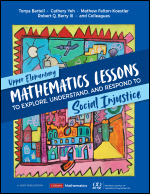Upper Elementary Mathematics Lessons to Explore, Understand, and Respond to Social Injustice
- Tonya Gau Bartell - Michigan State University, USA
- Cathery Yeh - The University of Texas at Austin, USA
- Mathew D. Felton-Koestler - Ohio University, Ohio, USA
- Robert Q. Berry III - University of Virginia, United States
Foreword by Julia M. Aguirre, Brian R. Lawler, Series Editor
Corwin Mathematics Series
“A very compelling set of fresh ideas are offered that prepare educators to turn the corner on advocating for social justice in the mathematics classroom. Each book is full of engaging activities, frameworks and standards that centers instruction on community, worldview, and the developmental needs of all students, a must needed resource to reboot our commitment to the next generation.”
Linda M. Fulmore
TODOS: Mathematics For ALL
Cave Creek, AZ
Empower students to be the change—join the teaching mathematics for social justice movement!
We live in an era in which students of all ages have—through media and their lived experiences— a more visceral experience of social injustices. However, when people think of social justice, mathematics rarely comes to mind. With a teacher-friendly design, this book brings upper elementary mathematics content to life by connecting it to student curiosity, empathy, and issues students see or experience.
Tested in Grades 3-5 classrooms, the model lessons in this book walk teachers through the process of applying critical frameworks to instruction, using standards-based mathematics to explore, understand, and respond to social justice issues. Learn to plan instruction that engages students in mathematics explorations through age-appropriate, culturally relevant topics, such as valuing differences, health and pay inequality, bullying, voting rights, and environmental justice. Features include:
- Content cross-referenced by mathematical concept and social issues
- Connection to Learning for Justice’s social justice standards
- Downloadable instructional materials and lesson resources
- Guidance for lessons driven by students’ unique passions and challenges
- Connections between research and practice
Written for teachers committed to developing equitable and just practices through the lens of mathematics content and practice standards as well as social justice standards, this book will help connect content to students’ daily lives, fortify their mathematical understanding, and expose them to issues that will support them in becoming active citizens and leaders.
Free resources
Lesson 5.6: Challenge Ableist Assumptions in Mathematics Problems
This lesson engages students in using their bodies (i.e., their fingers) as a physical representation to support skip-counting groups of 10. At the same time, students will also unpack this common practice to begin a conversation about body diversity.
A wonderful collection of lessons, submitted by teachers, to help students of all ages see topics they care about, and use mathematics as a tool for progress in the world.
A very compelling set of fresh ideas are offered that prepare educators to turn the corner on advocating for social justice in the mathematics classroom. Each book is full of engaging activities, frameworks, and standards that center instruction on community, worldview, and the developmental needs of all students—a much-needed resource to reboot our commitment to the next generation.
Upper Elementary Mathematics Lessons to Explore, Understand, and Respond to Social Injustice is an outstanding addition to the growing number of texts and projects that weave the teaching of mathematics and social justice together. The authors go deep and broad to show how, why, and when this combination of curricular topics improves our students’ mathematical understandings while honing their abilities and dispositions to promote social and environmental justice in their own lives and communities.
Teaching mathematics for social justice affirms the relevance of mathematics instruction to the “real world” and equips educators and students to turn their engagement with mathematics concepts into positive social action. Equal parts approachable and challenging, the lessons get students thinking critically about how mathematics helps them to understand, identify injustice, and develop the skills and confidence to right it.
This is the book so many of us in upper elementary mathematics have been waiting for. It’s practical, justice oriented, and student-centered. For elementary school teachers looking to integrate social justice lessons with a relevant and timely lens, this book will be instantly applicable to your practice. For everyone else, this book demonstrates that social justice mathematics is critical to the work we must do for our students, our communities, and our profession as mathematics teachers!
This book is a much-needed and timely resource for teachers, coaches, school leaders, and teacher educators. The authors offer a wide array of lessons that get to the heart of teaching mathematics for social justice for students in Grades 3–5. The diverse topics share a common thread: a commitment to students’ learning grounded in meaningful and relevant explorations.
I imagine many people will purchase this book for the sample lesson plans. And you should; they’re fabulous. But just as fabulous, and equally important, is the framework the authors lay out for a comprehensive, holistic, transformative approach to mathematics teaching, with social justice at its core.
As a teacher educator for social justice, I am familiar with the near-constant refrain of “this isn’t something you can do in math!” This book illustrates just the opposite. Indeed, not only is it possible to engage in social justice mathematics, but it is an educational imperative to do so. This much-needed and valuable collection provides practitioners with clear and compelling lessons that are grounded in theories of justice and equity. Especially timely in this text is the clear evidence that not only can upper elementary–aged children engage in critical conversations, problem solving, and sociocultural analysis in their mathematics classes, but they must. The editors and contributors to this volume have curated a powerful resource that is a must-read for all mathematics educators and those who care about social justice teaching and learning.

